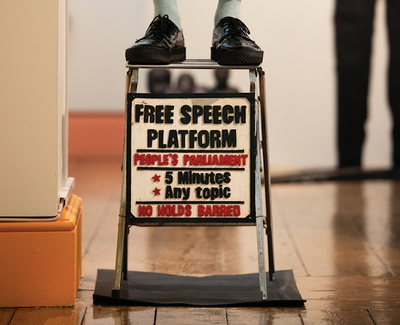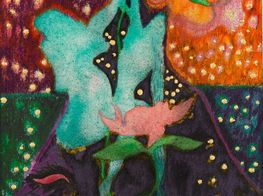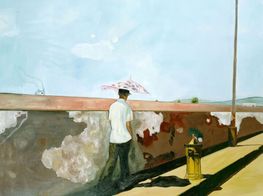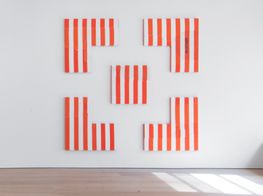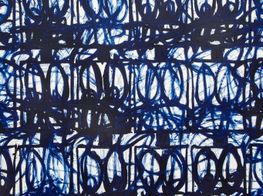Get Up, Stand Up Now: Generations of Black Creative Pioneers at Somerset House
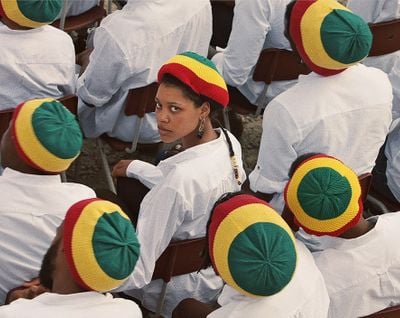
Jenn Nkiru, video for Neneh Cherry, 'Kong' (2018) (still). © Jenn Nkiru. Courtesy the artist.
Get Up Stand Up Now: Generations of Black Creative Pioneers at Somerset House in London (12 June–15 September 2019) surveys more than half a century of black creativity in Britain and beyond across the fields of art, film, photography, music, design, fashion, and literature.
Curated by Zak Ové, works by approximately 100 intergenerational black (and several non-black) artists deal with histories of migration and coloniality as well as postcolonial, diasporic, and future legacies, from Che Lovelace, co-founder of StudioFilmClub with Peter Doig, to Mercury Prize-winning group Young Fathers. Artists reflecting on the transatlantic African-American diasporic experience include David Hammons, Carrie Mae Weems, Hank Willis Thomas, Rashid Johnson, and Sanford Biggers—a move that Ové sees as essential for exploring commonalities and solidarities with U.S. artists across generations.1
Taking over Somerset House's West Wing galleries, white neoclassical spaces have been transformed by British-Nigerian product designer and artist Yinka Ilori, who introduced vivid painted walls and patterned designs throughout, including a bold, totemic doorway intervention. In this setting, histories and geographies collide in full force, with 15 interconnected rooms containing an array of artworks, archival materials, and listening stations for curated music.
The birth of multicultural Britain in the 1960s is the point of departure, as documented in photographs and films from the archive of Horace Ové, the curator's father. Ové was a key figure of Pan-African internationalism. In 1960, he arrived in London from Trinidad and Tobago to study painting, photography, and interior design—an endeavour he abandoned in favour of documentary filmmaking and photography to capture the personal, political, and social events affecting black people at the time. These included the first Black Power meetings with Stokely Carmichael, Allen Ginsberg, and Michael X (founder of the Black Power movement in the U.K.), seminal speeches by James Baldwin, and the establishment of Notting Hill Carnival by the Windrush generation in the 1970s and 80s. Ové's 1976 film Pressure, credited as the first feature-length film directed by a black British filmmaker, deals with the identity and racial struggles experienced by children of immigrants who came to Britain in the 1960s.
Ové's work is shown alongside peers from the Windrush generation, including photographers Charlie Phillips, Armet Francis, and Vanley Burke, and artist Aubrey Williams. The Windrush generation served in the British armed forces during World War II and were invited to work in the U.K. between 1948 and 1971 from Caribbean countries, including Jamaica, Trinidad and Tobago, and Barbados, travelling on a ship called the Empire Windrush. These migrant workers left their home countries 'for self-improvement through employment', normally taking on work Britons 'were unable to perform due to lack of training', or thought of as 'too inferior for them to undertake.'2 The Windrush arrivals were confronted with a hostile and racist environment and accused of stealing jobs, resources, and enabling crime, paralleling the anti-migrant narrative that fed into the Brexit vote.
Nevertheless, writes historian Harry Goulbourne, this period marked 'the thrust away from a relatively mono-cultural to a multi-cultural Britain', shaped by 'contributions from a wide variety of African, Asian, European, but particularly Caribbean societies.'3 Artworks explore the effects this period had on generations that emerged from Windrush—entangled in what scholars Louise Waite and Joanne Cook describe as 'practices and expressions' shaped by the complex relationships between culturally diverse communities and host societies, with 'feelings of belonging ... stretched and simultaneously "here and there".'4 From multidisciplinary practices dealing with identity politics by Lubaina Himid and Sonia Boyce to paintings by Denzil Forrester and Chris Ofili, this survey's historical trajectory of entanglement continues to the present.
Black Audio Film Collective are given an entire space for their seminal, 80-minute film Who Needs A Heart (1991), which highlights the overlooked and turbulent history of the Black Power movement and its central figure, Michael Abdul Malik, through the lens of a group of friends and lovers. The intimate also comes through in Ajamu's photos capturing queer black experiences—BodyBuilder in Bra (1990), for example, depicts, in black and white, the back of a muscular man in a bra, probing the notions of masculinity and sexuality through the queer black male subject. While Phoebe Boswell's three-channel video installation, I Need to Believe the World is Still Beautiful (2018), decentres the male gaze by celebrating black female bodies through depictions in drawing and moving image.
There is a blurring of disciplinary boundaries among a younger generation—evident in the art house films of Jenn Nkiru, the director widely known for the video of Beyoncé and Jay-Z's song 'APESH*T', Mowalola Ogunlesi's bold genre- and gender-bending menswear collection that draws on the culture of her native Lagos, to the work of experimental fashion designer Grace Wales Bonner, represented with a photograph by the late Lord Snowdon depicting friends Dennis Okwera and Wilson Oryema dressed in Bonner's second fashion collection. Bonner recently curated A Time for New Dreams, a group exhibition at the Serpentine Sackler Gallery in London (19 January–17 March 2019), which explored the 'magical resonances within black cultural and aesthetic practices.'
In one succinctly curated gallery, history folds into the present. Ishmahil Blagrove Jr's Free Speech Platform (2015) invites participation for free speech by mounting a step ladder placed next to Horace Ové's seminal film Baldwin Nigger (1969)—a conversation between James Baldwin and Dick Gregory comparing blackness in the United States and Britain. The ladder will be activated in a workshop on 6 July, with a public performance by Barby Asante, Rabz Lansiquot, and Imani Robinson based on a re-inscribed script from Ové's film on 8 July.
Positioned nearby is Satch Hoyt's IcePick (2002): a frosted Afro comb with a raised fist for a handle placed within a clarinet case lined with red velvet. A pair of headphones accompany the piece, through which the sound of two African-American women combing their hair is audible. A recognised symbol of black pride and solidarity, the representation of the raised fist on a culturally symbolic grooming tool from the 1970s blends with the timeless sound of the action associated with it, demonstrating the multiple associations across generations of significant forms and gestures.
Throughout the exhibition, works speak to the rich connections across generations and geographies, 'asserting the importance of an intergenerational lens in exploring generational differences and similarities in the shaping of post-migration lives.'5 Larry Achiampong's Relic 1 (2017) underscores this assertion: a short film in which a child dressed as an astronaut walks through desolate U.K. sites while describing feelings of otherness and anxieties of belonging. Touching on postcoloniality, imaginary landscapes, and migratory narratives, Relic 1 forms part of a larger multidisciplinary project spanning performance, audio, moving image, and prose characterised by futuristic, cross-cultural, and post-digital explorations of identity.
Forward-facing formulations of Afrofuturism populate the final rooms, with works like Keith Piper's Robot Bodies (2001–2007), a single screen installation merging racial metaphors with science fiction, and Jenn Nkiru's Afro-surrealist visuals in the music videos for Neneh Cherry's song 'Kong' (2018) and Kamasi Washington's 'Hub Tones' (2018). Musician GAIKA's new audio-visual installation Heaters 4 The 2 Seaters (2019), made of multiple screens, gaming devices, and audio elements, likens the current geopolitical and economic climate to a 'home shopping experience, replete with purchasable in-game products, a dose of liberal guilt, tax-free deportations and the War on Drugs (™).'
The show ends with another kind of threshold, located in an alcove between a screening room and a final gallery. Doubling as a reading and resting area, Shrine to Wisdom (2019) is a stunning mixed-media installation with vibrant white drawings covering bright blue walls by Victor Ekpuk, who has long incorporated traditional Nigerian Nsibidi graphics and writing systems in his works.
While the entire scope of individuals working across disciplines and media is too extensive to condense or contain in a single show, Get Up, Stand Up Now stakes a rightful claim on the evolution of British culture in the 20th century by the specific communities who came to form contemporary post-imperial society in Britain during a period marked by several historic moments. These include the partition of India in 1947, which triggered movements of millions within the Indian sub-continent, and led to significant numbers making their way to the U.K.; and the ending of British colonial rule on the African continent, which saw communities of Africans as well as South Asians in Kenya, Tanzania, and Malawi migrating to Britain in the 1960s and 70s. Get Up, Stand Up Now is a celebration of the influence these communities have had on culture and creativity amidst oppressive and racist struggles, while highlighting the solidarities that connected movements in the U.S.A. and the African continent.
Of course, multiple visits and several hours are required for visitors to fully engage with the breadth and scope offered in this landmark show, described by Somerset House as the first of its kind. With a no re-entry policy, a more succinct selection of artworks would have served as a compromise for those who can't visit twice.—[O]
—


